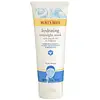What's inside
What's inside
 Key Ingredients
Key Ingredients

 Benefits
Benefits

 Concerns
Concerns

 Ingredients Side-by-side
Ingredients Side-by-side

Water
Skin ConditioningDipropylene Glycol
HumectantPEG-240/Hdi Copolymer Bis-Decyltetradeceth-20 Ether
StabilisingCaprylic/Capric Triglyceride
MaskingGlycerin
HumectantPEG-100 Stearate
Macadamia Integrifolia Seed Oil
Skin ConditioningDimethicone
EmollientGlyceryl Stearate
EmollientGlycereth-26
HumectantCaprylyl Glycol
EmollientAllantoin
Skin ConditioningTocopheryl Acetate
AntioxidantCaprylhydroxamic Acid
Adenosine
Skin ConditioningPortulaca Oleracea Extract
Skin ConditioningParfum
MaskingDisodium EDTA
Butylene Glycol
HumectantPhenoxyethanol
PreservativeSodium Hyaluronate
HumectantPolyglutamic Acid
Skin ConditioningCI 42090
Cosmetic ColorantWater, Dipropylene Glycol, PEG-240/Hdi Copolymer Bis-Decyltetradeceth-20 Ether, Caprylic/Capric Triglyceride, Glycerin, PEG-100 Stearate, Macadamia Integrifolia Seed Oil, Dimethicone, Glyceryl Stearate, Glycereth-26, Caprylyl Glycol, Allantoin, Tocopheryl Acetate, Caprylhydroxamic Acid, Adenosine, Portulaca Oleracea Extract, Parfum, Disodium EDTA, Butylene Glycol, Phenoxyethanol, Sodium Hyaluronate, Polyglutamic Acid, CI 42090
Water
Skin ConditioningRicinus Communis Seed Oil
MaskingGlycerin
HumectantCetyl Alcohol
EmollientStearyl Alcohol
EmollientCocos Nucifera Oil
MaskingGlyceryl Stearate
EmollientPropanediol
SolventBeeswax
Emulsion StabilisingStearic Acid
CleansingPersea Gratissima Oil
Skin ConditioningLactobacillus
Skin ConditioningSalvia Sclarea Extract
AntiseborrhoeicPolymnia Sonchifolia Root Juice
Skin ConditioningAstrocaryum Tucuma Seed Butter
EmollientTrichilia Emetica Seed Butter
EmollientHelianthus Annuus Seed Wax
Skin ConditioningGlycine Soja Oil
EmollientAlpha-Glucan Oligosaccharide
CleansingTocopherol
AntioxidantXanthan Gum
EmulsifyingLecithin
EmollientSodium PCA
HumectantZinc PCA
HumectantMaltodextrin
AbsorbentPotassium Stearate
CleansingPotassium Sorbate
PreservativeSodium Benzoate
MaskingParfum
MaskingPhenoxyethanol
PreservativeCitral
PerfumingLimonene
PerfumingLinalool
PerfumingWater, Ricinus Communis Seed Oil, Glycerin, Cetyl Alcohol, Stearyl Alcohol, Cocos Nucifera Oil, Glyceryl Stearate, Propanediol, Beeswax, Stearic Acid, Persea Gratissima Oil, Lactobacillus, Salvia Sclarea Extract, Polymnia Sonchifolia Root Juice, Astrocaryum Tucuma Seed Butter, Trichilia Emetica Seed Butter, Helianthus Annuus Seed Wax, Glycine Soja Oil, Alpha-Glucan Oligosaccharide, Tocopherol, Xanthan Gum, Lecithin, Sodium PCA, Zinc PCA, Maltodextrin, Potassium Stearate, Potassium Sorbate, Sodium Benzoate, Parfum, Phenoxyethanol, Citral, Limonene, Linalool
Ingredients Explained
These ingredients are found in both products.
Ingredients higher up in an ingredient list are typically present in a larger amount.
Glycerin is already naturally found in your skin. It helps moisturize and protect your skin.
A study from 2016 found glycerin to be more effective as a humectant than AHAs and hyaluronic acid.
As a humectant, it helps the skin stay hydrated by pulling moisture to your skin. The low molecular weight of glycerin allows it to pull moisture into the deeper layers of your skin.
Hydrated skin improves your skin barrier; Your skin barrier helps protect against irritants and bacteria.
Glycerin has also been found to have antimicrobial and antiviral properties. Due to these properties, glycerin is often used in wound and burn treatments.
In cosmetics, glycerin is usually derived from plants such as soybean or palm. However, it can also be sourced from animals, such as tallow or animal fat.
This ingredient is organic, colorless, odorless, and non-toxic.
Glycerin is the name for this ingredient in American English. British English uses Glycerol/Glycerine.
Learn more about GlycerinGlyceryl Stearate is a mix of glycerin and stearic acid.
It is used to stabilize the mixing of water and oil ingredients. By preventing these ingredients from separating, it can help elongate shelf life. It can also help thicken the product's texture.
As an emollient, it helps soften skin and supports barrier-replenishing ingredients.
In cosmetics, Glyceryl Stearate is often made from vegetable oils or synthetically produced.
This ingredient may not be fungal-acne safe
Fun fact: The human body also creates Glyceryl Stearate naturally.
Learn more about Glyceryl StearateParfum is a catch-all term for an ingredient or more that is used to give a scent to products.
Also called "fragrance", this ingredient can be a blend of hundreds of chemicals or plant oils. This means every product with "fragrance" or "parfum" in the ingredients list is a different mixture.
For instance, Habanolide is a proprietary trade name for a specific aroma chemical. When used as a fragrance ingredient in cosmetics, most aroma chemicals fall under the broad labeling category of “FRAGRANCE” or “PARFUM” according to EU and US regulations.
The term 'parfum' or 'fragrance' is not regulated in many countries. In many cases, it is up to the brand to define this term.
For instance, many brands choose to label themselves as "fragrance-free" because they are not using synthetic fragrances. However, their products may still contain ingredients such as essential oils that are considered a fragrance by INCI standards.
One example is Calendula flower extract. Calendula is an essential oil that still imparts a scent or 'fragrance'.
Depending on the blend, the ingredients in the mixture can cause allergies and sensitivities on the skin. Some ingredients that are known EU allergens include linalool and citronellol.
Parfum can also be used to mask or cover an unpleasant scent.
The bottom line is: not all fragrances/parfum/ingredients are created equally. If you are worried about fragrances, we recommend taking a closer look at an ingredient. And of course, we always recommend speaking with a professional.
Learn more about ParfumPhenoxyethanol is a preservative that has germicide, antimicrobial, and aromatic properties. Studies show that phenoxyethanol can prevent microbial growth. By itself, it has a scent that is similar to that of a rose.
It's often used in formulations along with Caprylyl Glycol to preserve the shelf life of products.
Water. It's the most common cosmetic ingredient of all. You'll usually see it at the top of ingredient lists, meaning that it makes up the largest part of the product.
So why is it so popular? Water most often acts as a solvent - this means that it helps dissolve other ingredients into the formulation.
You'll also recognize water as that liquid we all need to stay alive. If you see this, drink a glass of water. Stay hydrated!
Learn more about Water